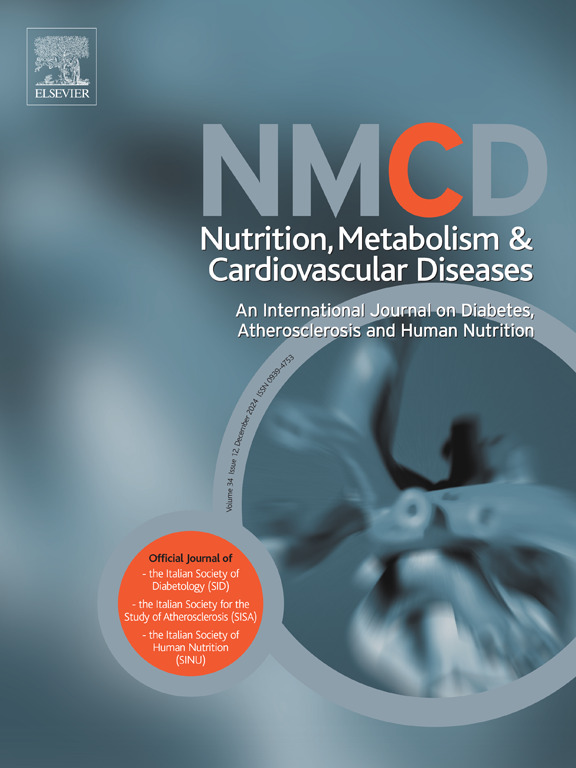Uric acid reference values for children and adolescents should be stratified by pubertal stage
IF 3.3
3区 医学
Q2 CARDIAC & CARDIOVASCULAR SYSTEMS
Nutrition Metabolism and Cardiovascular Diseases
Pub Date : 2024-09-12
DOI:10.1016/j.numecd.2024.09.009
引用次数: 0
Abstract
Background and aim
To establish reference values for hyperuricemia (HUA) in children and adolescents.
Methods and results
The study enrolled 4807 students from “The Evaluation and Monitoring on School-based Nutrition and Growth in Shenzhen study.” Utilizing quantile regression, associations between age, body mass index (BMI), pubertal stage, and serum uric acid (SUA) were examined, alongside the relationship between SUA and cardiovascular disease (CVD) risk factors. Reference values for SUA were explored using receiver operating characteristic analysis, considering sex and pubertal stage. The prevalence of HUA was 34.3 % for boys and 29 % for girls (using the adult HUA diagnostic criteria: >420 μmol/L for males, >360 μmol/L for females), increasing with higher BMI, age, and pubertal stage. Pubertal stage had the largest influence on SUA in boys, while nutritional status was the most significant factor affecting SUA in girls. Adjusting for age and pubertal stage, higher SUA levels correlated with an increased risk of CVD risk factors. Proposed reference values included >360 μmol/L for girls ages 6–17 years and prepubertal boys. For pubertal boys, reference values varied based on age: >392 μmol/L for ages 9–11 in early-middle puberty, >429 μmol/L for ages 12–14 in early-middle puberty, >478 μmol/L for ages 12–14 in late puberty, and >505 μmol/L for ages 15–17 in late puberty.
Conclusions
Stratifying HUA reference values by pubertal stage, particularly for boys, is crucial. Long-term follow-up of individuals with high SUA levels may aid in refining SUA reference values.
儿童和青少年的尿酸参考值应按青春期阶段分层。
背景和目的:确定儿童和青少年高尿酸血症(HUA)的参考值:该研究从 "深圳校本营养与成长评价监测研究 "中招募了 4807 名学生。研究利用量子回归法考察了年龄、体重指数(BMI)、青春期阶段与血清尿酸(SUA)之间的关系,以及SUA与心血管疾病(CVD)风险因素之间的关系。在考虑性别和青春期阶段的情况下,使用接收器操作特征分析法探讨了 SUA 的参考值。男孩的 HUA 患病率为 34.3%,女孩为 29%(采用成人 HUA 诊断标准:男性>420 μmol/L,女性>360 μmol/L),随着体重指数(BMI)、年龄和青春期阶段的增加而增加。青春期阶段对男孩 SUA 的影响最大,而营养状况则是影响女孩 SUA 的最重要因素。调整年龄和青春期阶段后,较高的 SUA 水平与心血管疾病风险因素的增加相关。对于 6-17 岁的女孩和青春期前的男孩,建议的参考值包括 >360 μmol/L。对于青春期男孩,参考值因年龄而异:青春期早中期的 9-11 岁男孩的参考值>392 μmol/L,青春期早中期的 12-14 岁男孩的参考值>429 μmol/L,青春期晚期的 12-14 岁男孩的参考值>478 μmol/L,青春期晚期的 15-17 岁男孩的参考值>505 μmol/L:按青春期阶段划分 HUA 参考值至关重要,尤其是对男孩而言。对 SUA 水平较高的个体进行长期随访有助于完善 SUA 参考值。
本文章由计算机程序翻译,如有差异,请以英文原文为准。
求助全文
约1分钟内获得全文
求助全文
来源期刊
CiteScore
6.80
自引率
2.60%
发文量
332
审稿时长
57 days
期刊介绍:
Nutrition, Metabolism & Cardiovascular Diseases is a forum designed to focus on the powerful interplay between nutritional and metabolic alterations, and cardiovascular disorders. It aims to be a highly qualified tool to help refine strategies against the nutrition-related epidemics of metabolic and cardiovascular diseases. By presenting original clinical and experimental findings, it introduces readers and authors into a rapidly developing area of clinical and preventive medicine, including also vascular biology. Of particular concern are the origins, the mechanisms and the means to prevent and control diabetes, atherosclerosis, hypertension, and other nutrition-related diseases.

 求助内容:
求助内容: 应助结果提醒方式:
应助结果提醒方式:


